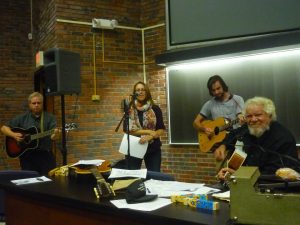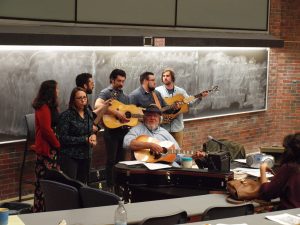joannd
It’s our first, perfect seventy-degree spring day this semester; the kind when offices and classrooms might swelter before the campus turns on the a/c. Then why am I sitting at my desk humming “White Christmas” in mid-April? The classic Irving Berlin tune calls to mind the bittersweet nostalgia of holidays past. Crosby first performed the song on live radio just weeks after the Pearl Harbor attack, so it conjures for many Americans the patriotic pathos of soldiers missing home. But the song’s complicated identity regarding war, specifically in Operation Frequent Wind (April 1975) to signal selective evacuations nearing the Fall of Saigon, cannot be whitewashed entirely. Poet Ocean Vuong reminds us of this in “Aubade with Burning City,” which he intersperses with lyrics from “White Christmas” to create a fragmented, surreal scene: petals float like snowflakes, bodies scatter and burn, and an American soldier and his Vietnamese lover part. Berlin wrote the song in one night, and proclaimed, “Not only is it the best song I ever wrote, it’s the best song anybody ever wrote.” Sounds like my TA cohort pulling all-nighters in graduate school, or any writer on a manic, caffeine-induced, creative high in love with their own poetry and genius. It also sounds a bit like Stoney. Our New Paltz poet-teacher-bard was his own compelling mix of humility, gritandlove, with a side of self-grandeur. But with a CV that long he’d earned all those bragging rights.
A few years ago, we were in the office late grading or prepping for classes. It was nearing winter break, and I was listening to holiday music in my office, no doubt loudly humming along. Stoney came around the corner and stopped in my doorway to see what was playing. Scrolling through the playlist, we talked about our favorites, anything by Bing, the Rat Pack, Judy Garland, Nat King Cole, The Andrews Sisters, et al. I was a little girl in my grandparents’ wood paneled kitchen again, hearing my grandfather croon along with the radio while baking his famous Hungarian kolache (“strudel” as he called it). Stoney and I began singing along, too. We had a laugh during “Mele Kalikimaka” and he reminisced about his travels to Hawaii.
I think about Stoney’s love for song and variations on songs like “Barbara Allen,” and for his undertaking of the political and personal endeavor that is teaching poems, ballads, and songs. Every year in the Understanding Poetry course that he founded nearly forty years ago (that I’ve had the gift of co-ordinating and co-teaching), he performed the same lecture at the grand finale, and it was fresh each time. He loved sharing his knowledge of the folk tradition, of English and American ballads, quoting Williams, Dylan, Guthrie, even himself. The course’s existence asserted that that the study of music (not just canonical) was scholarly, that social protest and communal sound as art form worked alongside of and intersected with the great tradition of literature. But it was not all academic. Stoney wanted to make poetry fun and make nonsense sounds (sh-boom, sh-boom) until everyone sang along. (If you think it’s easy to get a room full of university students to break into a round of “You Are My Sunshine,” just try it…and good luck to you). Because he so clearly believed in what he was teaching-singing-doing, though, you could hardly help yourself from joining in for a chorus. Of course, Stoney was an entertainer who knew how to hold his audience. As a mentor and educator, Stoney’s love for the connection that teaching fostered was evident (see the dedication poem, “My Last Students”). Students flocked to him outside of Humanities and JFT, hopped rides in his van to Kentucky or on flights to conferences in Hemingway’s Paris and beyond. The community he created remains boundless. Stoney saw poetry everywhere and knew how necessary it was to teach and delight. He had a generous heart and mind.


I am thinking of a story Stoney shared via email in April of 2020 from the pandemic “zone of isolation,” as he called it: “I had a kind of resurrection dream Easter morning—another Dewy Dell, her double or was it her, showed up at my door. (DDell=my most beloved Russian Blue Gray-Ghost Cat buried a year ago.) Then Sparrow followed her in the door. But that was after too many Easter drinks.” He goes on to say how he’d been singing along to Methodist hymns on television and on YouTube that echoed from “various sad empty cathedrals,” “missing the hell out of loved ones […].” That he’d been consoling friends and loved ones feeling alone by email and phone more than ever before. He even joked about starting a Zoom hymn sing-along. Stoney knew that what we sing rises to places unseen and raises the spirit. That our voices ring with an oral history that deserves preserving (hence, the Understanding Poetry course). That our stories tell seemingly ineffable experiences that clarify and distil a moment in a life, that keep memory and time, that cultivate compassion. There is no greater work than this, and there is no greater joy than living it. He signed off, “So in this season of cancellation of almost everything, nothing can cancel my Hope, my Hallelujah Anyway, and my loveandsongs—-Stoney.” This, as with all of his goodbyes, like lilacs blooming.[1]
I think about Stoney, a poet whose lines sang and could not be restrained. They danced off the damn page but caught up in the refrain, their rhythm, you’d get lost happily chasing down allusions. His poems had a perceptive depth yet also a paradoxical playfulness so clearly a signature of their maker. In the Shawangunk Review (2011) “‘The First Step toward Comprehension’: Poets on the Making of Their Poems,” Stoney develops on thoughts from French resistance writer and diplomat Stephane Hessel, who “tells his readers […] what poets know: poetry is a life and death matter” (67). Agreed…writing, reading, and sharing it.
This section further explores “where poems come from and how and why poets write them” to unearth “a deeper understanding of poetry, to a restoration of the sense of mystery regarding the act of creation and the well-wrought poem” (68). One of Harry’s most transformative poems, “Hudson River Voices” lives in this section and his explanation of the form and composition of the poem is, in true Eliotic style, as long or nearly longer than the poem itself. The piece details a haunting scene of voices floating over the water, reaching unexpected ears and corners of shacks and mansions, intertwining harmony and cacophony, pondering existence and afterlife:
[…] sometimes late-night
raucous singing with a crowd, bone-fire voices
raised against the darkness, sometimes just
the two of us singing away the ghosts
of eternity […]. (lines 28-32)
Stoney describes the idea for this poem arriving as he sat at a stop light, where he scribbled down a phrase. Later, as he typed the words, bone-fire came out instead of bonfire. “…I thought now isn’t that interesting. […] It’s a good fire, C’est bon” (88). He dives into the etymologies and linguistic layers, subconscious associations that make the mistake work, recalling that “poetry should be burnt to the bone by austere fires” (West qtd in Stoneback 89), an idea-image that appears in the poem. Though this is a profoundly meditative piece, he ends his composition notes by reminding us that “Poetry should give us permission to have fun. That typo was fun. Typos have the power to teach and delight” (89).
I think about Stoney a lot though it’s difficult sometimes thinking about him since he moved on because I miss so much his voice, his ever-widening smile… all in the eyes, his cut-to-the-quick wit. I wish we could sing together again. Talk cats and the weather and poems. I wish that we’d gotten to record “I’ll Fly Away” and “Keep on the Sunny Side” for his gospel album in progress (among another ten projects, no doubt). “Check in with me around New Year re. recording a tune or two,” he wrote in December just weeks before his passing. Though we had to begin a new year without him, I’m so grateful for the ones we had, and for the words, books, poems, and songs that keep him near. In “Hudson River Voices,” the speaker reflects on the way language moves and anchors us, especially the way poetry and song inhabit a moment, revive a place, leave a trace, shapeshift time:
Austere voices, burnt to the bone,
voices heard over the midnight river
may be the only thing that lasts and marks
the earth with the sign: we have been here
and we did our best to sing, sing it all. (lines 42-46)
Stoney did his best to sing it all. I wish I had listened to him in October of 2021 when he told me, “Enjoy today—probably our last perfect sunny 70s day until next April.” I never made it outside that day, or today as I sit to finish writing these lines for him now. Yet I am warmed by his words–their good fire and bones–this April, even as the forecast for cold rain and snowfall arrived late this spring near Easter.
[1] Eliot’s, Whitman’s, or both.
